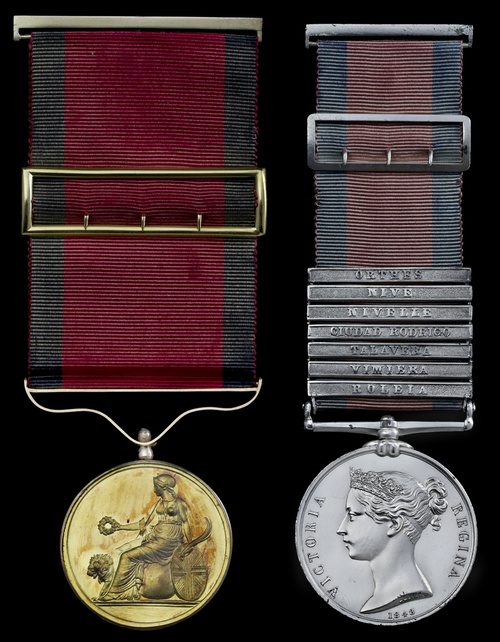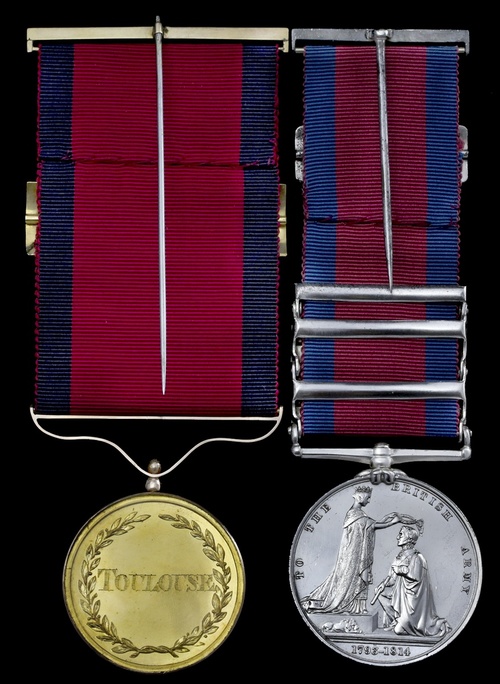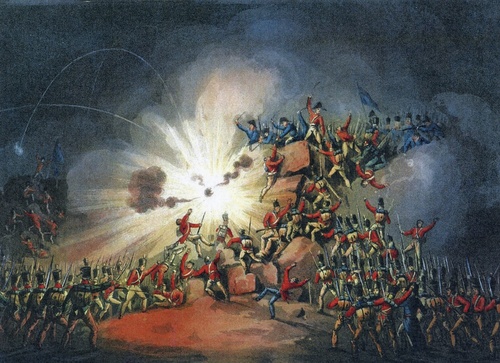Auction: 19002 - Orders, Decorations and Medals
Lot: 277
Sold by Order of a Direct Descendant
'… a very zealous and active Officer.'
Colonel H. Tolley, C.B., on Major A. Martin
The outstanding Field Officer's Gold Medal pair awarded to Major A. Martin, 45th Regiment
Martin shared in the glories of the Peninsula War and wrote his name into its history on several occasions - notably when selflessly commanding the Forlorn Hope at Cuidad Rodrigo having already been 'dreadfully wounded' and latterly when displaying 'the special characteristics of the 45th - steadiness and stubborness' at Orthes
His finest hour came when the command devolved on him during the Battle of Toulouse; for his excellent service on that bloody day he became part of a small band of Captains to be rewarded with the Field Officer's Gold Medal
Field Officer’s Gold Medal 1808-14, for Toulouse (Captn. Alexr. Martin, 45th. Regt.) complete with gold riband buckle; Military General Service 1793-1814, 7 clasps, Roleia, Vimiera, Talavera, Cuidad Rodrigo, Nivelle, Nive, Orthes (Alexr. Martin, Surn. 45th Foot), with silver riband buckle, both fitted with top riband bars, with long pins as originally worn, nearly extremely fine, with shaped and fitted custom glazed frame which they have been housed for well over a century (2)
MAJOR ALEXANDER MARTIN (c.1782-1857),
45TH (1ST NOTTINGHAMSHIRE) REGIMENT OF FOOT.
Alexander Martin is thought to have been born in England in about 1782: his age at death, in 1857, was recorded as being 75. However, in the 1841 Scotland Census his age was recorded as 50 and in that of 1851 it was recorded as 59; in both censuses he was noted as being born in England. Since he was first commissioned in 1802, and is unlikely to have been commissioned at the age of about 11, it seems probable that his age on the two censuses was incorrectly recorded. In a regimental Inspection Return of 1822, his age was recorded as being 38 - implying a year of birth of about 1784. His Death Certificate recorded that his father, Alexander, had been a soldier and that his mother's first name had been Sophia, so he may have been the Alexander Martin with parents of those names who was baptised in St. Martin-in-the-Fields, Westminster, in November 1786. Other than those few sparse and inconsistent details, his family background appears unknown, as are details of his education.
He was commissioned Ensign in the 45th (1st Nottinghamshire) Regiment of Foot on 31st March 1802; his commission was purchased vice a promotion in the regiment and his social condition was recorded as 'gent.'. When Martin joined his regiment it was stationed in in Ireland. On 26th March 1803, after nearly a year as an Ensign, Martin was able to purchase promotion to Lieutenant, vice a retirement. The 45th remained in Ireland until December 1805 when it left, disembarking early in January 1806 at Ramsgate and subsequently encamping at Brabourne Lees in Kent. At that time, Martin was Lieutenant in the Company commanded by Captain William Smith but in February 1806 he transferred to that commanded by Captain Leonard Greenwell, in whose company - the Light Infantry Company - he remained for the next two years. The resumption of war with France in 1803, and with Spain after 1804, necessitated the raising of 2nd Battalions in many regiments of the Line, among which was the 45th. It was with the 1st/45th that Martin first experienced active service.
Into action in South America
Late in 1806, the 1st/45th participated in an expedition sent to South America as reinforcements for troops that had captured the Spanish ports of Buenos Aires and Montevideo. Buenos Aires having been quickly recaptured by the Spanish, the reinforcements were required in order to retake the city. After landing, in June 1807, Greenwell's Light Company of the 1st/45th was combined with other regiments' Light Companies to form a Light Infantry Battalion within a Brigade commanded by Colonel Robert Craufurd. Craufurd's Brigade formed the right flank in the attack on Buenos Aires on 5th July and achieved its objectives, penetrating deep into the city and capturing several buildings. However, the British were unable to hold the city against overwhelming Spanish forces and a truce was agreed, after which the British re-embarked and sailed for Montevideo. It seems probable that Martin was in the thick of the fighting in Buenos Aires since his Company commander, Greenwell, was among those wounded and Martin briefly made a prisoner-of-war. The Battalion returned to Ireland late in December 1807.
Peninsula campaigns
The 1st/45th embarked for Portugal in mid-July 1808, Martin being among the officers of the Battalion present at the time and still one of the two Lieutenants in Captain Greenwell's Light Company. The Battalion was present at the battles of Roliça and Vimeira in August 1808, Martin's involvement in both actions being confirmed by the eponymous clasps on his Military General Service Medal. The 1st/45th was among those British troops which remained in Portugal after the evacuations from Corunna and Vigo, over-wintering in Lisbon 1808-09.
On 1st April 1809, Martin was promoted Captain but in the 2nd Battalion; his promotion came without purchase, vice the appointment of a regimental officer to the Staff. For the remainder of the war, there was frequent 'cross-posting' between the 45th's two battalions - officers of one doing duty with the other - and so it was that Martin remained in the Peninsula and was present at the battle of Talavera in July 1809. By January 1810 he had returned to England to serve with the 2nd/45th in Nottingham, where he commanded the battalion's Light Company. The 2nd/45th moved from Nottingham to Guernsey in May 1810 and remained there until June 1811 when it was posted to Hilsea Barracks in Portsmouth; three months later, Martin accompanied a draft from the Battalion to join the 1st/45th in Spain.
Cuidad Rodrigo - forlorn hope - severe wound
It appears that Martin took over command of the Grenadier Company of the 1st/45th on arrival at Battalion headquarters in Spain in the autumn of 1811. A Battalion's Grenadier Company was expected to lead any assault on a fortified position and did just so at Ciudad Rodrigo on 19th January 1812. The 1st/45th was allocated the role of spearhead of the 3rd Division's assault. Although the walls had been breached by British artillery fire, there was still a glacis to be crossed and deep ditches to be negotiated, all in the face of exploding mines and withering fire from artillery and musketry. Under such circumstances, it was usual for the commander of the assaulting force to ask volunteers to form a 'forlorn hope' (from the Dutch: verloren hoop or 'lost troop') to lead the assault. Although few could expect to survive such a suicidal venture, there was glory in participation as well as probable promotion and prize money for the survivors - on the basis of 'the fewer men, the greater share of honour'. According to the account published in 1840 by Colonel James Campbell (in January 1812 a Captain in the 1st/45th), there was no shortage of volunteers among the officers and men of the 1st/45th for the forlorn hope at Ciudad Rodrigo but, 'the Captain of Grenadiers (now Major Martin), who was there dreadfully wounded, put an end to all difficulties by requesting leave to lead as he stood with his company at the head of the column.'
His command inspired the men and that evening they shared in 100 guineas from Picton, calling them to do him '…the honour to drink to the future success of the Third Division.'
It is evident, from all accounts, that Martin's wound, received in the breach at Ciudad Rodrigo, was 'severe', even 'dreadful', but no accurate account has yet been traced of exactly what it form it took - it should perhaps be noted that he failed to sire any issue in later life. When submitting his entry for volume five of Philippart's 'Royal Military Calendar' in about 1820, he recorded that he had, 'received a gun-shot wound through the body'. The Commissary John Edgcumbe Daniel wrote in 1820 that Martin had been, 'left in a hopeless state among the dead, his recovery was considered a perfect miracle', so it seems likely that he sustained a torso wound, probably from one or more musket balls. Whatever his wound, it necessitated more than a year's convalescence, first in Portugal and then in England. By March 1813, though, he was well enough to be stationed with the 2nd/45th at Lewes Barracks in Sussex and in September that year he returned to the 1st/45th in Spain.
Back into action
By the time that Martin re-joined the 1st/45th, Wellington's Army was poised to invade France and the Battalion participated in the battles of Nivelle and Nive to force the frontier; Martin was once again at the head of his grenadiers,. At the subsequent battle of Orthes, on 27th February 1814, the battalion was opposed to nearly the whole of the right of the French army and was hard-pressed for a time, but it held on with, as the regimental historian Colonel Dalbiac recorded in 1902, ' … the Grenadier company, under Captain Martin, gallantly repelling every effort of the French to dislodge them. At no time, perhaps during the whole war had the special characteristics of the 45th - steadiness and stubbornness - had been more splendidly displayed than they were on this occasion.'
At the subsequent battle of Toulouse on 10th April 1814, command of the 1st/45th devolved upon Martin when the Colonel was killed and his second-in-command wounded, so it fell to him to extract the Battalion from a battle in which it had been bloodily mauled. As a result of his leadership at Toulouse, Martin became one of the small number of Captains to be awarded a Field Officer's Gold Medal.
The 1st/45th returned home, to Ireland, late in July 1814 and remained there until January 1819. The apparent ending of the war with France in 1814 resulted in the disbandment of the 2nd/45th and in November 1814 Martin was recorded as en route from Plymouth with a draft of NCOs and men from the 2nd Battalion who were being transferred to the 1st Battalion in order to bring it up to strength. Late in December 1816, Martin bought a Majority in the regiment from Major David Lecky, who retired by sale of his commission. In January 1819, the regiment embarked for Ceylon (Sri Lanka), landing at Trincomalee early in July. By December 1819, Major Martin was stationed in Colombo, moving to Galle in March 1820 and remaining in the fort there until June. From February 1821, and for the remainder of his service with the 45th in Ceylon, Martin was commandant of the detachment at Badula (Badulla), in the hills south-east of Kandy. It was while he was there that Colonel Henry Tolley C.B., while completing an Inspection Return on the 45th in March 1821, recorded that, in his opinion, Major Martin was, ' … a very zealous and active Officer.' In November 1824, Martin embarked at Galle for Britain, granted leave for two years' absence. In the event, he did not return, retiring by the sale of his Major's commission to Captain Thomas Hilton in June 1825.
The sale of his commission would have netted Martin a reasonable sum and, as a result of his wound at Ciudad Rodrigo, he already had a permanent pension of £100 per annum (equivalent to about £58,000 in 2019): this would have enabled him to live comfortably in retirement.
Retirement - journey's end
He is recorded as having married twice, although the date and place of his first marriage has not been traced. His first wife was Ellen, or Eleanor, second daughter of Hugh Lyle of Jackson Hall, Coleraine, Co. Londonderry; the marriage appears to have been childless. At some point, Martin appears to have lived in Belfast - his will records him as 'formerly of Belfast' - but by 1837 he and his first wife were living at Mayville Cottage in the Ayrshire coastal town of Stevenston. By 1842, the couple had moved to Montgomerie Street, Ardrossan, where Ellen Martin died in August that year. Martin's second wife was Frances Hilton Miller, a daughter of John Miller, a prosperous Glasgow merchant with extensive West Indian interests. Frances was some forty years Alexander's junior and they married in Glasgow in January 1844; the marriage was also childless. Their property in Ardrossan was large enough to incorporate a stable and a coach house and to accommodate four servants as well as the family. Martin was sufficiently prosperous to settle £5,000 on his young wife at the time of their marriage.
It appears that Major Alexander Martin enjoyed an intellectually active retirement, while living on the Ayrshire coast. Students of the marine natural history of Scotland may be familiar with his name and reputation as an 'enthusiastic seabed sampler'; he was recorded in 2012 as a 'dredging companion' of two notable local natural historians, Professor J.H. Balfour and The Rev. David Lansborough, and in 1847 as, ' … a gentleman well-known as a lover of natural history, and as a successful collector of objects of zoological and botanical interest.' His military history as well as his interests were clearly known to Charles Kingsley, who memorialised him in 'Glaucus' in 1855 thus:
' …the gallant old Scotch officer mentioned by some writer on sea-weeds, who, desperately wounded in the breach at Badajos [sic], and a sharer in all the toils and triumphs of the Peninsular war, could in his old age show a rare sea-weed with as much triumph as his well-earned medals, and talk over a tiny spore-capsule with as much zest as the records of sieges and battles.'
Major Alexander Martin died in Ardrossan on 25th November 1857 and was buried in the Necropolis in Glasgow. His second wife survived him until 1878.
Reference sources:
Primary sources:
The National Archives:
Monthly Returns, WO 17; Muster Rolls and Pay Lists, WO 12; Inspection Returns WO 27.
Secondary sources:
Campbell, J., A British Army … (London, 1840).
Dalbiac, P.H., History of the 45th: 1st Nottinghamshire Regiment … (London, 1902).
Daniel, J.E., Journal of an Officer in the Commissariat Department of the Army … (London, 1820).
Moore, G., 'Major Alexander Martin and Lieutenant John Leavach …', Ayrshire Notes, Vol. 43 (2012), pp. 31-34.
Philippart, J., The Royal Military Calendar …, 5 vols. (London, 1820).
London Gazette 1802-25.
Wylly, H.C. (comp.), History of the 1st & 2nd Battalions The Sherwood Foresters …, 2 vols. (Frome & London, 1929).
Internet sources:
Ancestry.com; Arran Coast.com; Find My Past.com; Scotland's People.com
Subject to 20% VAT on Buyer’s Premium. For more information please view Terms and Conditions for Buyers.
Sold for
£22,000
Starting price
£18000













